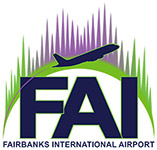
Alaska International Airport System
Fairbanks International Airport
6450 Airport Way
Fairbanks, Alaska 99709
Main: 907-474-2500
Fax: 907-474-2513
FOR IMMEDIATE RELEASE: July 24th, 2024
Contact: Zak Mitchell, 907-474-2596 | Dylan Blankenship, 907.521.7014
Fairbanks International Airport Welcomes Aurora to State Service, Alaska's Robotic Solution to Reducing Airport Wildlife Conflicts
(Fairbanks, AK) - Fairbanks International Airport is excited to welcome a groundbreaking addition to its wildlife management team. Meet Aurora, a state-of-the-art robotic dog, designed to enhance safety and efficiency in wildlife mitigation efforts.
Aurora is equipped with advanced sensors and programmable capabilities to patrol the airport grounds actively, deterring wildlife from entering runways and aircraft operation areas. This innovative approach is set to revolutionize how airports manage wildlife hazards, prioritizing safety, and operational efficacy.
Why Wildlife Mitigation Matters:
Wildlife presence at airports poses significant risks, including potential aircraft collisions that jeopardize passenger safety and cause costly damages. By integrating Aurora into our wildlife management protocols, the Alaska DOT&PF is taking a proactive step towards:
- Enhancing Safety: Reducing the risk of wildlife strikes to ensure the safety of passengers traveling through Fairbanks International Airport.
- Preventing Economic Loss: Minimizing aircraft damage and operational disruptions, which can lead to substantial financial costs.
- Promoting Humane Practices: Aurora operates in a way that harmlessly discourages wildlife, aligning with environmental conservation efforts and humane treatment standards.
- Ensuring Compliance and Efficiency: Meeting regulatory requirements set by aviation authorities and improving the efficiency of airport operations.
About Aurora:
Aurora, named after Alaska's famous northern lights, is a technologically advanced robot with the capability to navigate rugged terrains and endure harsh weather conditions prevalent in Interior Alaska. Her deployment at FAI marks the first time an American airport is utilizing a robotic dog for active wildlife control, setting a precedent for innovation in airport safety and wildlife management.
Aurora can operate for 90 minutes at time and takes 30 minutes to charge completely. Aurora's handler controls her movements by utilizing a handheld remote which allows them to see what she sees and determine the method of approach. She comes equipped with the ability to crawl, crouch, walk and sit. The scope of her abilities includes data collection, species identification, wildlife mitigation, and notification.
FAI has scheduled a Media Day for Thursday July 25 at 10 a.m. which will introduce Aurora to the public, showcase her agility, and address any questions about her purpose here at the airport.
The Alaska DOT&PF plans to monitor Aurora's impact on wildlife mitigation at FAI and assess the potential for broader implementation across other airports in the state. This pilot project is part of a larger initiative to incorporate more advanced technology solutions in the day-to-day operations of Alaska's transportation infrastructure.
This initiative not only highlights Alaska DOT&PF's commitment to safety and innovation but also positions Alaska at the forefront of integrating technology into public safety operations.
Follow us on Facebook to stay updated on Aurora's journey and other FAI initiatives.
###
About Fairbanks International Airport
Fairbanks International Airport is the gateway to Alaska’s interior and Denali National Park. It’s one half of the Alaska International Airport System and serves more than a million passengers annually. Equipped to handle any size and type of aircraft, anytime, with state-of-the-art landing systems and terminal facilities. Accounts for 1 in 20 jobs for a total of 1,900 jobs in Fairbanks.
About DOT&PF
The Alaska Department of Transportation and Public Facilities oversees 237 airports, 9 ferries serving 35 communities along 3,500 marine miles, over 5,600 miles of highway and 839 public facilities throughout the state of Alaska. The mission of the department is to “Keep Alaska Moving.”
###
